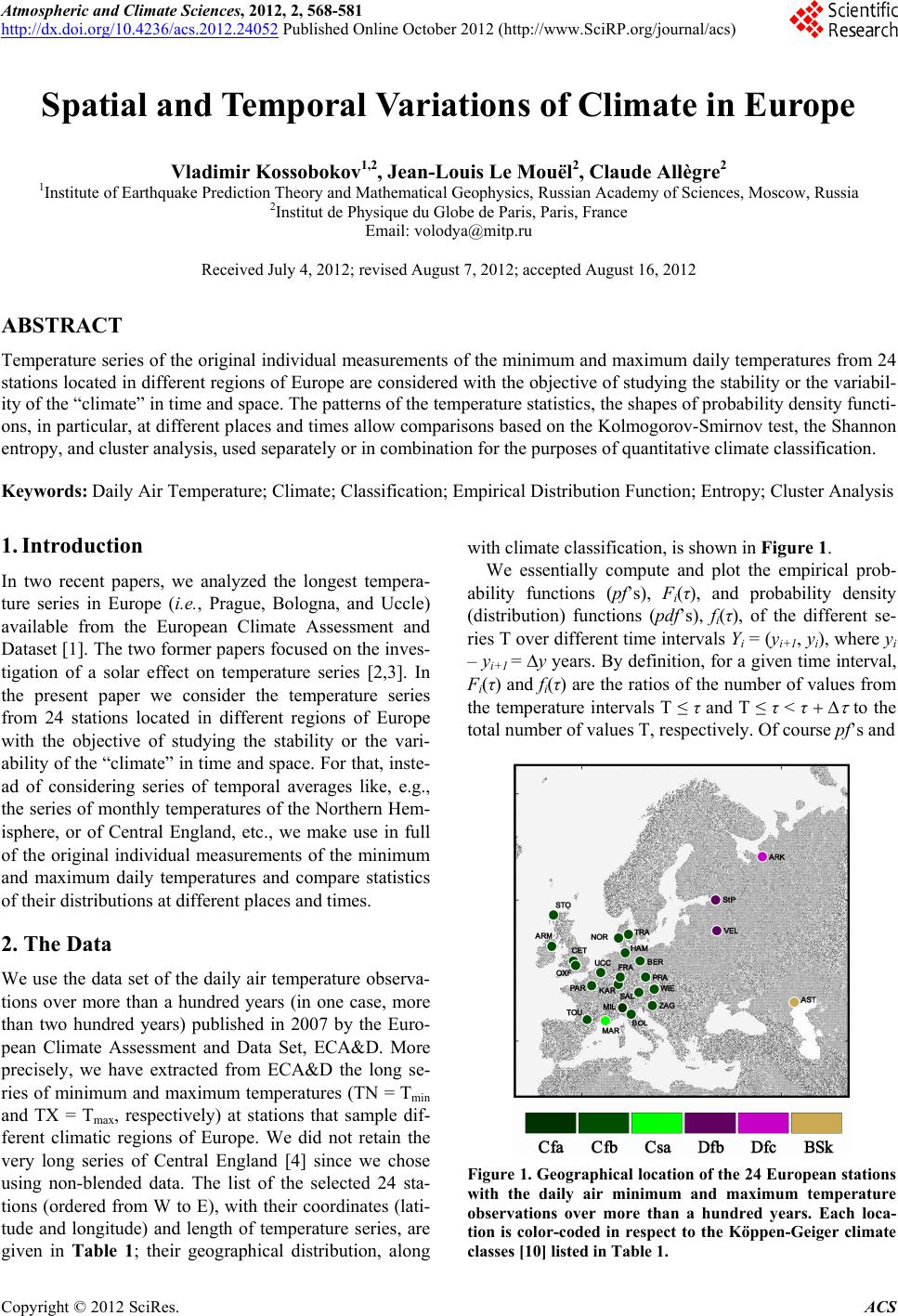 Atmospheric and Climate Sciences, 2012, 2, 568-581 http://dx.doi.org/10.4236/acs.2012.24052 Published Online October 2012 (http://www.SciRP.org/journal/acs) Spatial and Temporal Variations of Climate in Eur ope Vladimir Kossobokov1,2, Jean-Louis Le Mouël2, Claude Allègre2 1Institute of Earthquake Prediction Theory and Mathematical Geophysics, Russian Academy of Sciences, Moscow, Russia 2Institut de Physique du Globe de Paris, Paris, France Email: volodya@mitp.ru Received July 4, 2012; revised August 7, 2012; accepted August 16, 2012 ABSTRACT Temperature series of the original individual measurements of the minimum and maximum daily temperatures from 24 stations located in different regions of Europe are considered with the objective of studying the stability or the variabil- ity of the “climate” in time and space. The patterns of the temperature statistics, the shapes of probability density functi- ons, in particular, at different places and times allow comparisons based on the Kolmogorov-Smirnov test, the Shannon entropy, and cluster analysis, used separately or in combination for the purposes of quantitative climate classification. Keywords: Daily Air Temperature; Climate; Classification; Empirical Distribution Function; Entropy; Cluster Analysis 1. Introduction In two recent papers, we analyzed the longest tempera- ture series in Europe (i.e., Prague, Bologna, and Uccle) available from the European Climate Assessment and Dataset [1]. The two former papers focused on the inves- tigation of a solar effect on temperature series [2,3]. In the present paper we consider the temperature series from 24 stations located in different regions of Europe with the objective of studying the stability or the vari- ability of the “climate” in time and space. For that, inste- ad of considering series of temporal averages like, e.g., the series of monthly temperatures of the Northern Hem- isphere, or of Central England, etc., we make use in full of the original individual measurements of the minimum and maximum daily temperatures and compare statistics of their distributions at different places and times. 2. The Data We use the data set of the daily air temperature observa- tions over more than a hundred years (in one case, more than two hundred years) published in 2007 by the Euro- pean Climate Assessment and Data Set, ECA&D. More precisely, we have extracted from ECA&D the long se- ries of minimum and maximum temperatures (TN = Tmin and TX = Tmax, respectively) at stations that sample dif- ferent climatic regions of Europe. We did not retain the very long series of Central England [4] since we chose using non-blended data. The list of the selected 24 sta- tions (ordered from W to E), with their coordinates (lati- tude and longitude) and length of temperature series, are given in Table 1; their geographical distribution, along with climate classification, is shown in Figure 1. We essentially compute and plot the empirical prob- ability functions (pf’s), Fi(τ), and probability density (distribution) functions (pdf’s), fi(τ), of the different se- ries T over different time intervals Yi = (yi+1, yi), where yi – yi+1 = y years. By definition, for a given time interval, Fi(τ) and fi(τ) are the ratios of the number of values from the temperature intervals T ≤ τ and T ≤ τ < τ to the total number of values T, respectively. Of course pf’s and Figure 1. Geographical location of the 24 European stations with the daily air minimum and maximum temperature observations over more than a hundred years. Each loca- tion is color-coded in respect to the Köppen-Geiger climate classes [10] listed in Table 1. C opyright © 2012 SciRes. ACS 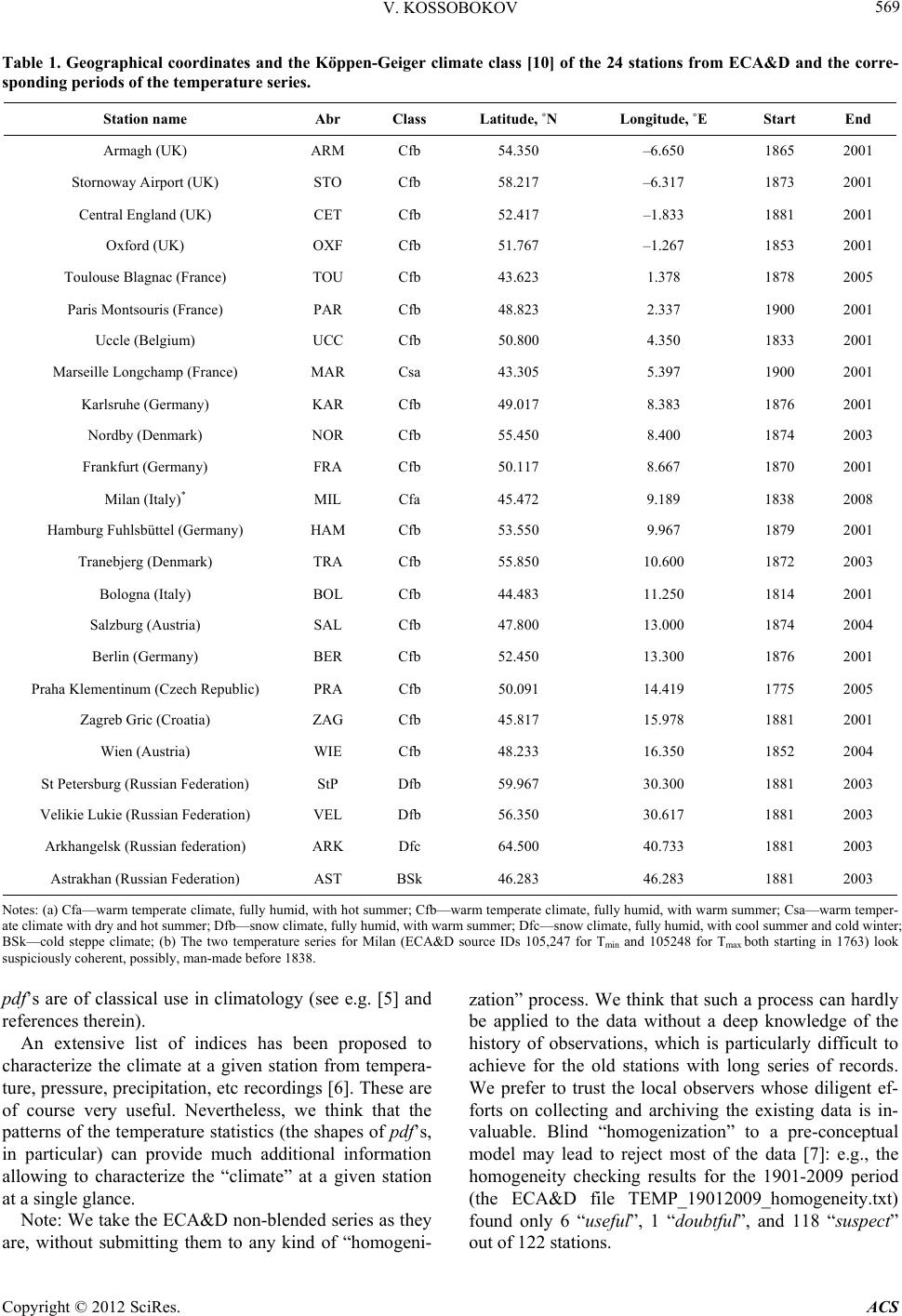 V. KOSSOBOKOV 569 Table 1. Geographical coordinates and the Köppen-Geiger climate class [10] of the 24 stations from ECA&D and the corre- sponding periods of the temperature series. Station name Abr Class Latitude, ˚N Longitude, ˚E Start End Armagh (UK) ARM Cfb 54.350 –6.650 1865 2001 Stornoway Airport (UK) STO Cfb 58.217 –6.317 1873 2001 Central England (UK) CET Cfb 52.417 –1.833 1881 2001 Oxford (UK) OXF Cfb 51.767 –1.267 1853 2001 Toulouse Blagnac (France) TOU Cfb 43.623 1.378 1878 2005 Paris Montsouris (France) PAR Cfb 48.823 2.337 1900 2001 Uccle (Belgium) UCC Cfb 50.800 4.350 1833 2001 Marseille Longchamp (France) MAR Csa 43.305 5.397 1900 2001 Karlsruhe (Germany) KAR Cfb 49.017 8.383 1876 2001 Nordby (Denmark) NOR Cfb 55.450 8.400 1874 2003 Frankfurt (Germany) FRA Cfb 50.117 8.667 1870 2001 Milan (Italy)* MIL Cfa 45.472 9.189 1838 2008 Hamburg Fuhlsbüttel (Germany) HAM Cfb 53.550 9.967 1879 2001 Tranebjerg (Denmark) TRA Cfb 55.850 10.600 1872 2003 Bologna (Italy) BOL Cfb 44.483 11.250 1814 2001 Salzburg (Austria) SAL Cfb 47.800 13.000 1874 2004 Berlin (Germany) BER Cfb 52.450 13.300 1876 2001 Praha Klementinum (Czech Republic) PRA Cfb 50.091 14.419 1775 2005 Zagreb Gric (Croatia) ZAG Cfb 45.817 15.978 1881 2001 Wien (Austria) WIE Cfb 48.233 16.350 1852 2004 St Petersburg (Russian Federation) StP Dfb 59.967 30.300 1881 2003 Velikie Lukie (Russian Federation) VEL Dfb 56.350 30.617 1881 2003 Arkhangelsk (Russian federation) ARK Dfc 64.500 40.733 1881 2003 Astrakhan (Russian Federation) AST BSk 46.283 46.283 1881 2003 Notes: (a) Cfa—warm temperate climate, fully humid, with hot summer; Cfb—warm temperate climate, fully humid, with warm summer; Csa—warm temper- ate climate with dry and hot summer; Dfb—snow climate, fully humid, with warm summer; Dfc—snow climate, fully humid, with cool summer and cold winter; BSk—cold steppe climate; (b) The two temperature series for Milan (ECA&D source IDs 105,247 for Tmin and 105248 for Tmax both starting in 1763) look suspiciously coherent, possibly, man-made before 1838. pdf’s are of classical use in climatology (see e.g. [5] and references therein). An extensive list of indices has been proposed to characterize the climate at a given station from tempera- ture, pressure, precipitation, etc recordings [6]. These are of course very useful. Nevertheless, we think that the patterns of the temperature statistics (the shapes of pdf’s, in particular) can provide much additional information allowing to characterize the “climate” at a given station at a single glance. Note: We take the ECA&D non-blended series as they are, without submitting them to any kind of “homogeni- zation” process. We think that such a process can hardly be applied to the data without a deep knowledge of the history of observations, which is particularly difficult to achieve for the old stations with long series of records. We prefer to trust the local observers whose diligent ef- forts on collecting and archiving the existing data is in- valuable. Blind “homogenization” to a pre-conceptual model may lead to reject most of the data [7]: e.g., the homogeneity checking results for the 1901-2009 period (the ECA&D file TEMP_19012009_homogeneity.txt) found only 6 “useful”, 1 “doubtful”, and 118 “suspect” out of 122 stations. Copyright © 2012 SciRes. ACS 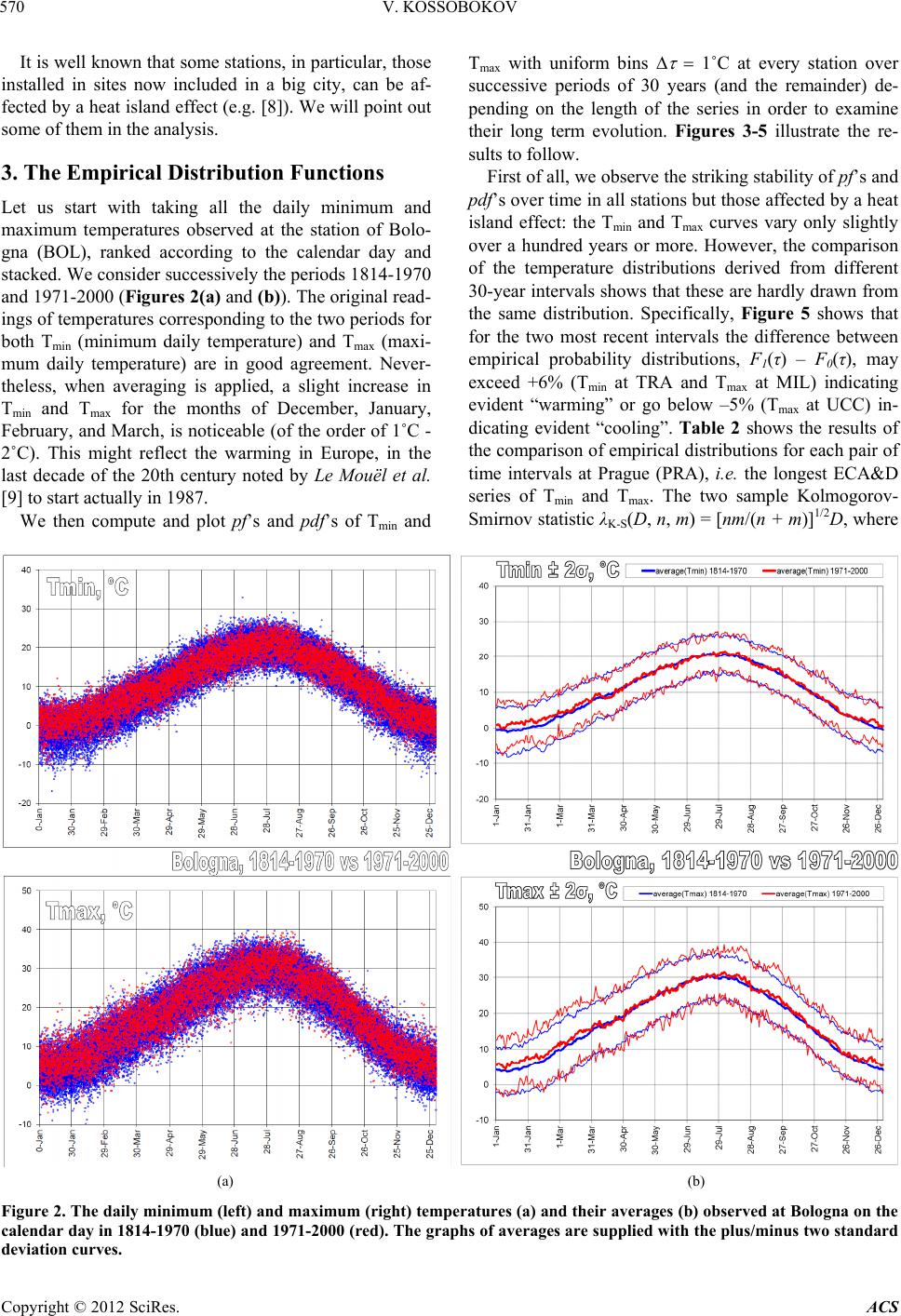 V. KOSSOBOKOV 570 It is well known that some stations, in particular, those installed in sites now included in a big city, can be af- fected by a heat island effect (e.g. [8]). We will point out some of them in the analysis. 3. The Empirical Distribution Functions Let us start with taking all the daily minimum and maximum temperatures observed at the station of Bolo- gna (BOL), ranked according to the calendar day and stacked. We consider successively the periods 1814-1970 and 1971-2000 (Figures 2(a) and (b)). The original read- ings of temperatures corresponding to the two periods for both Tmin (minimum daily temperature) and Tmax (maxi- mum daily temperature) are in good agreement. Never- theless, when averaging is applied, a slight increase in Tmin and Tmax for the months of December, January, February, and March, is noticeable (of the order of 1˚C - 2˚C). This might reflect the warming in Europe, in the last decade of the 20th century noted by Le Mouël et al. [9] to start actually in 1987. We then compute and plot pf’s and pdf’s of Tmin and Tmax with uniform bins 1˚C at every station over successive periods of 30 years (and the remainder) de- pending on the length of the series in order to examine their long term evolution. Figures 3-5 illustrate the re- sults to follow. First of all, we observe the striking stability of pf’s and pdf’s over time in all stations but those affected by a heat island effect: the Tmin and Tmax curves vary only slightly over a hundred years or more. However, the comparison of the temperature distributions derived from different 30-year intervals shows that these are hardly drawn from the same distribution. Specifically, Figure 5 shows that for the two most recent intervals the difference between empirical probability distributions, F1(τ) – F0(τ), may exceed +6% (Tmin at TRA and Tmax at MIL) indicating evident “warming” or go below –5% (Tmax at UCC) in- dicating evident “cooling”. Table 2 shows the results of the comparison of empirical distributions for each pair of time intervals at Prague (PRA), i.e. the longest ECA&D series of Tmin and Tmax . The two sample Kolmogorov- Smirnov statistic λK-S(D, n, m) = [nm/( n + m)]1/2D, where (a) (b) Figure 2. The daily minimum (left) and maximum (right) temperatures (a) and their averages (b) observed at Bologna on the calendar day in 1814-1970 (blue) and 1971-2000 (red). The graphs of averages are supplied with the plus/minus two standard deviation curves. Copyright © 2012 SciRes. ACS 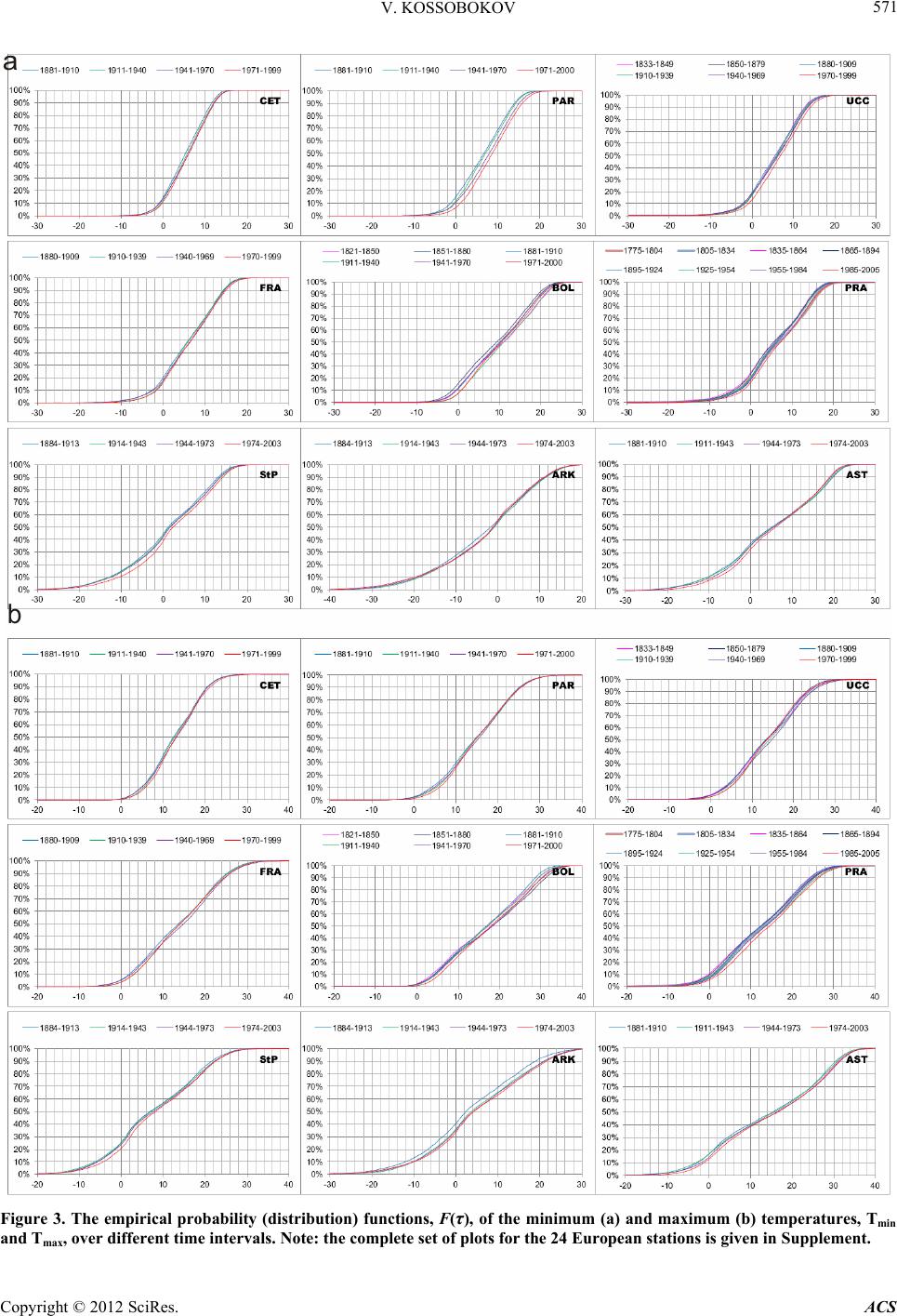 V. KOSSOBOKOV 571 a b Figure 3. The empirical probability (distribution) functions, F(τ), of the minimum (a) and maximum (b) temperatures, Tmin and Tmax, over different time intervals. Note: the complete set of plots for the 24 European stations is given in Supplement. Copyright © 2012 SciRes. ACS 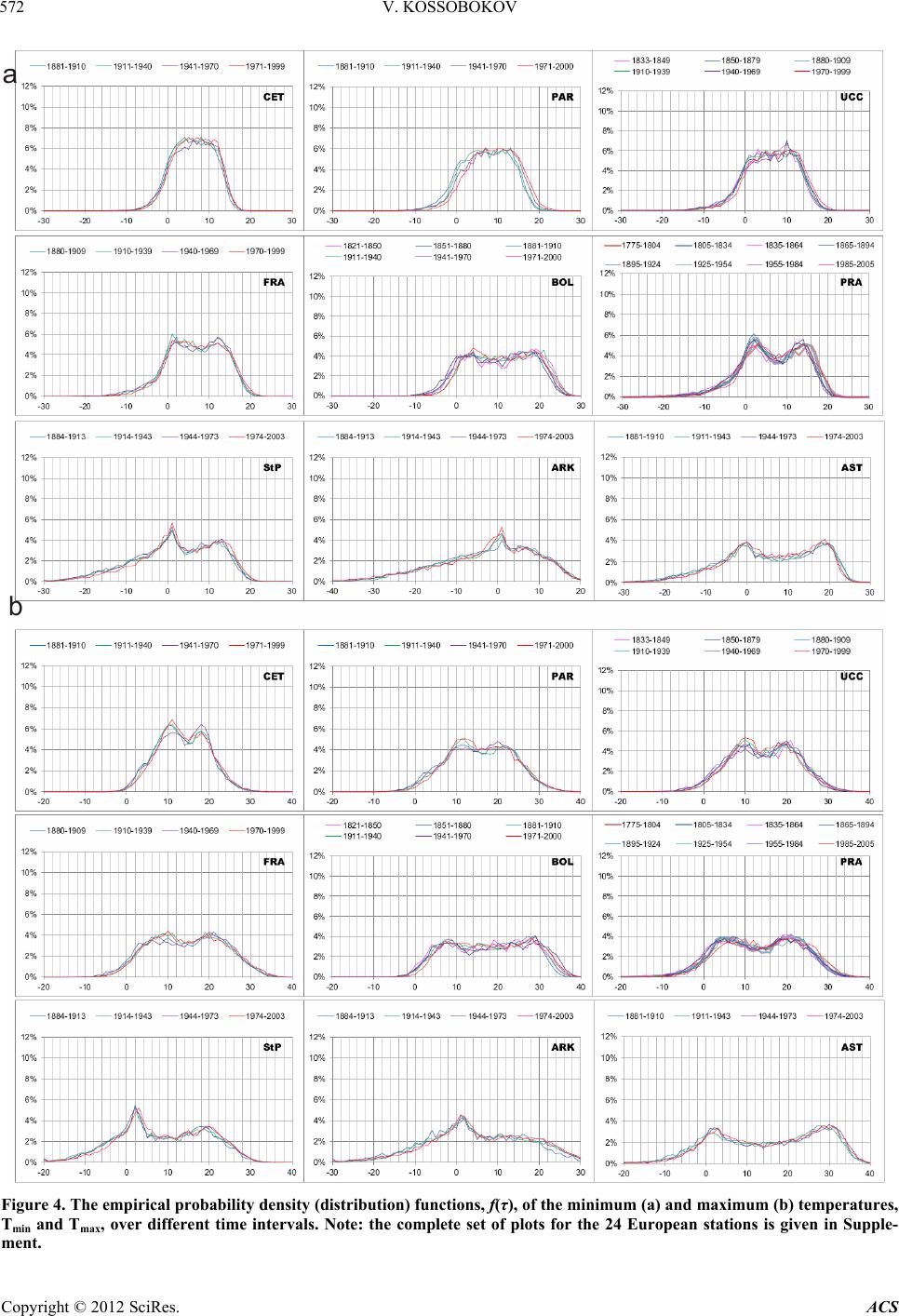 V. KOSSOBOKOV 572 a b Figure 4. The empirical probability density (distribution) functions, f(τ), of the minimum (a) and maximum (b) temperatures, Tmin and Tmax, over different time intervals. Note: the complete set of plots for the 24 European stations is given in Supple- ment. Copyright © 2012 SciRes. ACS 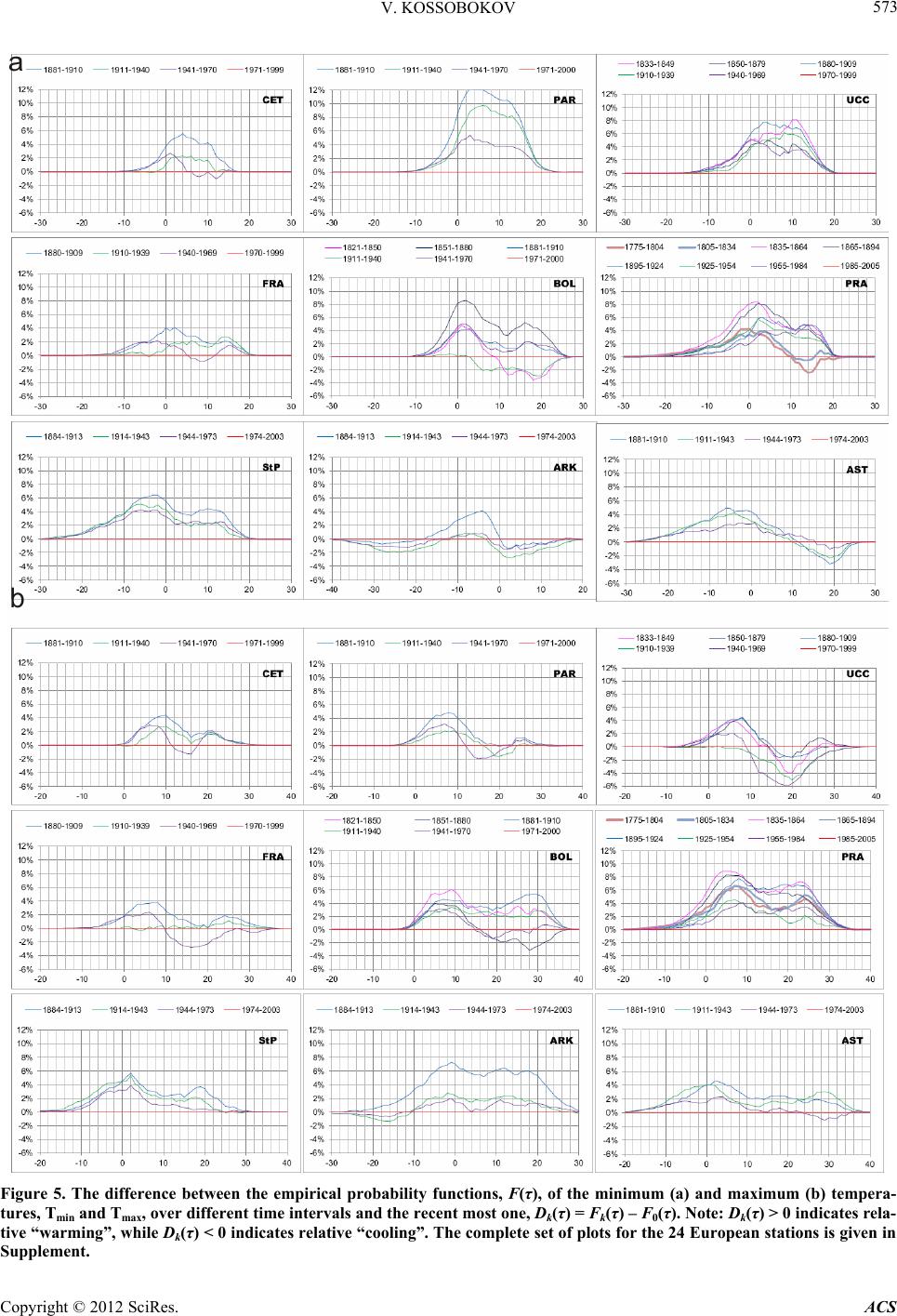 V. KOSSOBOKOV 573 a b Figure 5. The difference between the empirical probability functions, F(τ), of the minimum (a) and maximum (b) tempera- tures, Tmin and Tmax, over different time intervals and the recent most one, Dk(τ) = Fk(τ) – F0(τ). Note: Dk(τ) > 0 indicates rela- tive “warm ing”, while Dk(τ) < 0 indicates relative “cooling”. The complete set of plots for the 24 European stations is given in Supplement. Copyright © 2012 SciRes. ACS 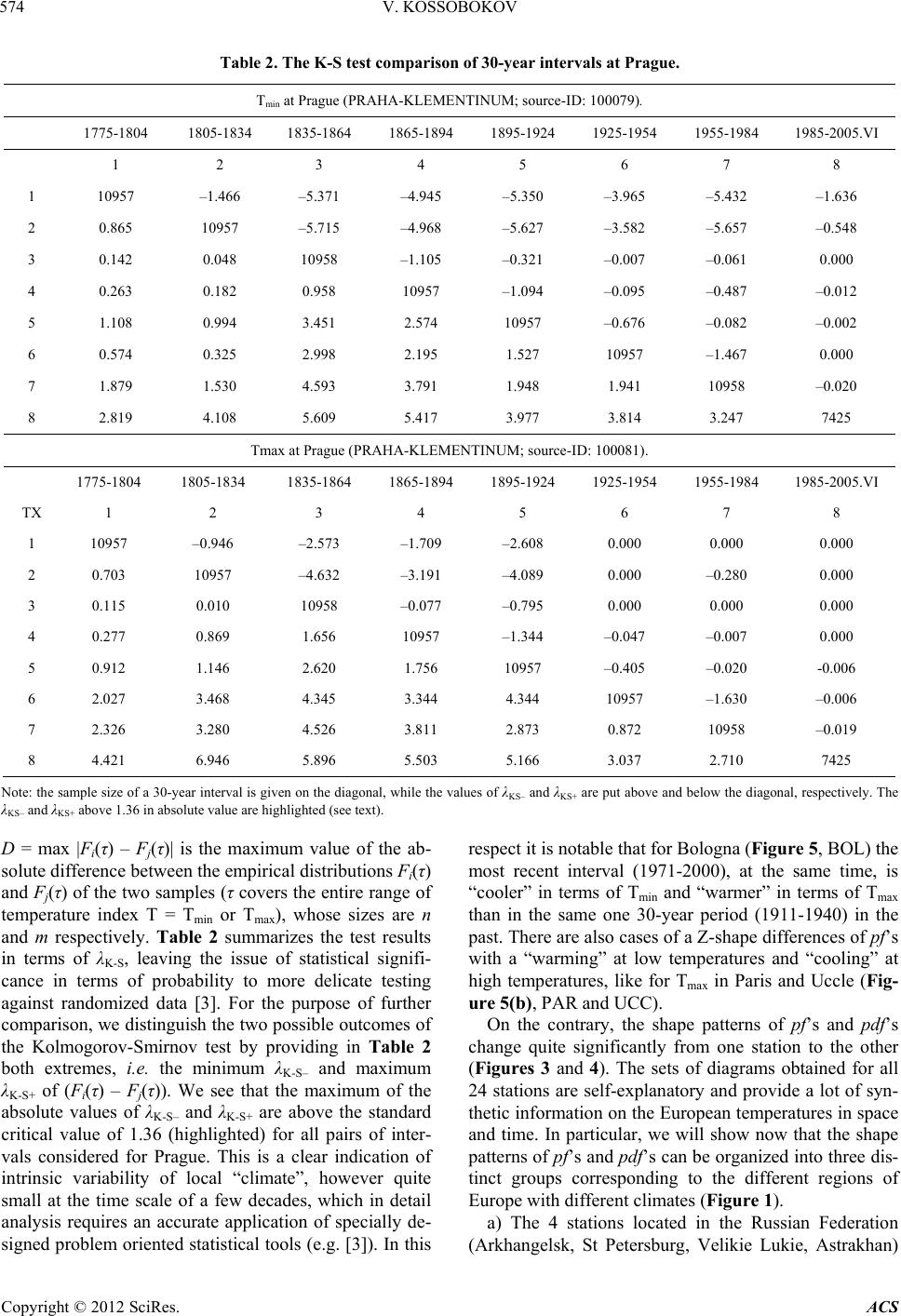 V. KOSSOBOKOV Copyright © 2012 SciRes. ACS 574 Table 2. The K-S test comparison of 30-year intervals at Prague. Tmin at Prague (PRAHA-KLEMENTINUM; source-ID: 100079). 1775-1804 1805-1834 1835-1864 1865-1894 1895-1924 1925-1954 1955-1984 1985-2005.VI 1 2 3 4 5 6 7 8 1 10957 –1.466 –5.371 –4.945 –5.350 –3.965 –5.432 –1.636 2 0.865 10957 –5.715 –4.968 –5.627 –3.582 –5.657 –0.548 3 0.142 0.048 10958 –1.105 –0.321 –0.007 –0.061 0.000 4 0.263 0.182 0.958 10957 –1.094 –0.095 –0.487 –0.012 5 1.108 0.994 3.451 2.574 10957 –0.676 –0.082 –0.002 6 0.574 0.325 2.998 2.195 1.527 10957 –1.467 0.000 7 1.879 1.530 4.593 3.791 1.948 1.941 10958 –0.020 8 2.819 4.108 5.609 5.417 3.977 3.814 3.247 7425 Tmax at Prague (PRAHA-KLEMENTINUM; source-ID: 100081). 1775-1804 1805-1834 1835-1864 1865-1894 1895-1924 1925-1954 1955-1984 1985-2005.VI TX 1 2 3 4 5 6 7 8 1 10957 –0.946 –2.573 –1.709 –2.608 0.000 0.000 0.000 2 0.703 10957 –4.632 –3.191 –4.089 0.000 –0.280 0.000 3 0.115 0.010 10958 –0.077 –0.795 0.000 0.000 0.000 4 0.277 0.869 1.656 10957 –1.344 –0.047 –0.007 0.000 5 0.912 1.146 2.620 1.756 10957 –0.405 –0.020 -0.006 6 2.027 3.468 4.345 3.344 4.344 10957 –1.630 –0.006 7 2.326 3.280 4.526 3.811 2.873 0.872 10958 –0.019 8 4.421 6.946 5.896 5.503 5.166 3.037 2.710 7425 Note: the sample size of a 30-year interval is given on the diagonal, while the values of λKS– and λKS+ are put above and below the diagonal, respectively. The λKS– and λKS+ above 1.36 in absolute value are highlighted (see text). D = max |Fi(τ) – Fj(τ)| is the maximum value of the ab- solute difference between the empirical distributions Fi(τ) and Fj(τ) of the two samples (τ covers the entire range of temperature index T = Tmin or Tmax), whose sizes are n and m respectively. Table 2 summarizes the test results in terms of λK-S, leaving the issue of statistical signifi- cance in terms of probability to more delicate testing against randomized data [3]. For the purpose of further comparison, we distinguish the two possible outcomes of the Kolmogorov-Smirnov test by providing in Table 2 both extremes, i.e. the minimum λK-S– and maximum λK-S+ of (Fi(τ) – Fj(τ)). We see that the maximum of the absolute values of λK-S– and λK-S+ are above the standard critical value of 1.36 (highlighted) for all pairs of inter- vals considered for Prague. This is a clear indication of intrinsic variability of local “climate”, however quite small at the time scale of a few decades, which in detail analysis requires an accurate application of specially de- signed problem oriented statistical tools (e.g. [3]). In this respect it is notable that for Bologna (Figure 5, BOL) the most recent interval (1971-2000), at the same time, is “cooler” in terms of Tmin and “warmer” in terms of Tmax than in the same one 30-year period (1911-1940) in the past. There are also cases of a Z-shape differences of pf’s with a “warming” at low temperatures and “cooling” at high temperatures, like for Tmax in Paris and Uccle (Fig- ure 5(b), PAR and UCC). On the contrary, the shape patterns of pf’s and pdf’s change quite significantly from one station to the other (Figures 3 and 4). The sets of diagrams obtained for all 24 stations are self-explanatory and provide a lot of syn- thetic information on the European temperatures in space and time. In particular, we will show now that the shape patterns of pf’s and pdf’s can be organized into three dis- tinct groups corresponding to the different regions of Europe with different climates (Figure 1). a) The 4 stations located in the Russian Federation (Arkhangelsk, St Petersburg, Velikie Lukie, Astrakhan) 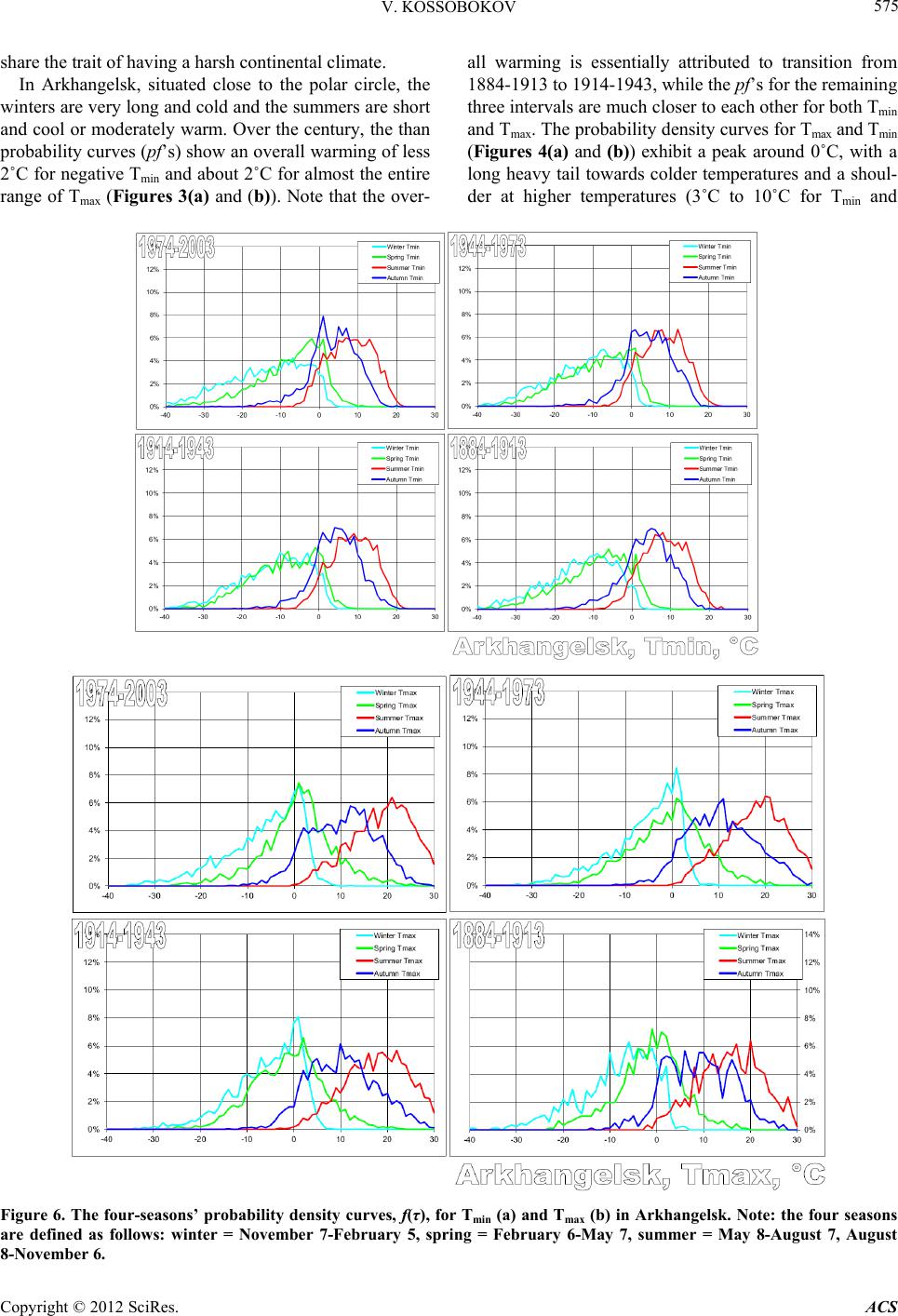 V. KOSSOBOKOV 575 share the trait of having a harsh continental climate. In Arkhangelsk, situated close to the polar circle, the winters are very long and cold and the summers are short and cool or moderately warm. Over the century, the than probability curves (pf’s) show an overall warming of less 2˚C for negative Tmin and about 2˚C for almost the entire range of Tmax (Figures 3(a) and (b)). Note that the over- all warming is essentially attributed to transition from 1884-1913 to 1914-1943, while the pf’s for the remaining three intervals are much closer to each other for both Tmin and Tmax. The probability density curves for Tmax and Tmin (Figures 4(a) and (b)) exhibit a peak around 0˚C, with a long heavy tail towards colder temperatures and a shoul- der at higher temperatures (3˚C to 10˚C for Tmin and Figure 6. The four-seasons’ probability density curves, f(τ), for Tmin (a) and Tmax (b) in Arkhangelsk. Note: the four seasons are defined as follows: winter = November 7-February 5, spring = February 6-May 7, summer = May 8-August 7, August 8-November 6. Copyright © 2012 SciRes. ACS 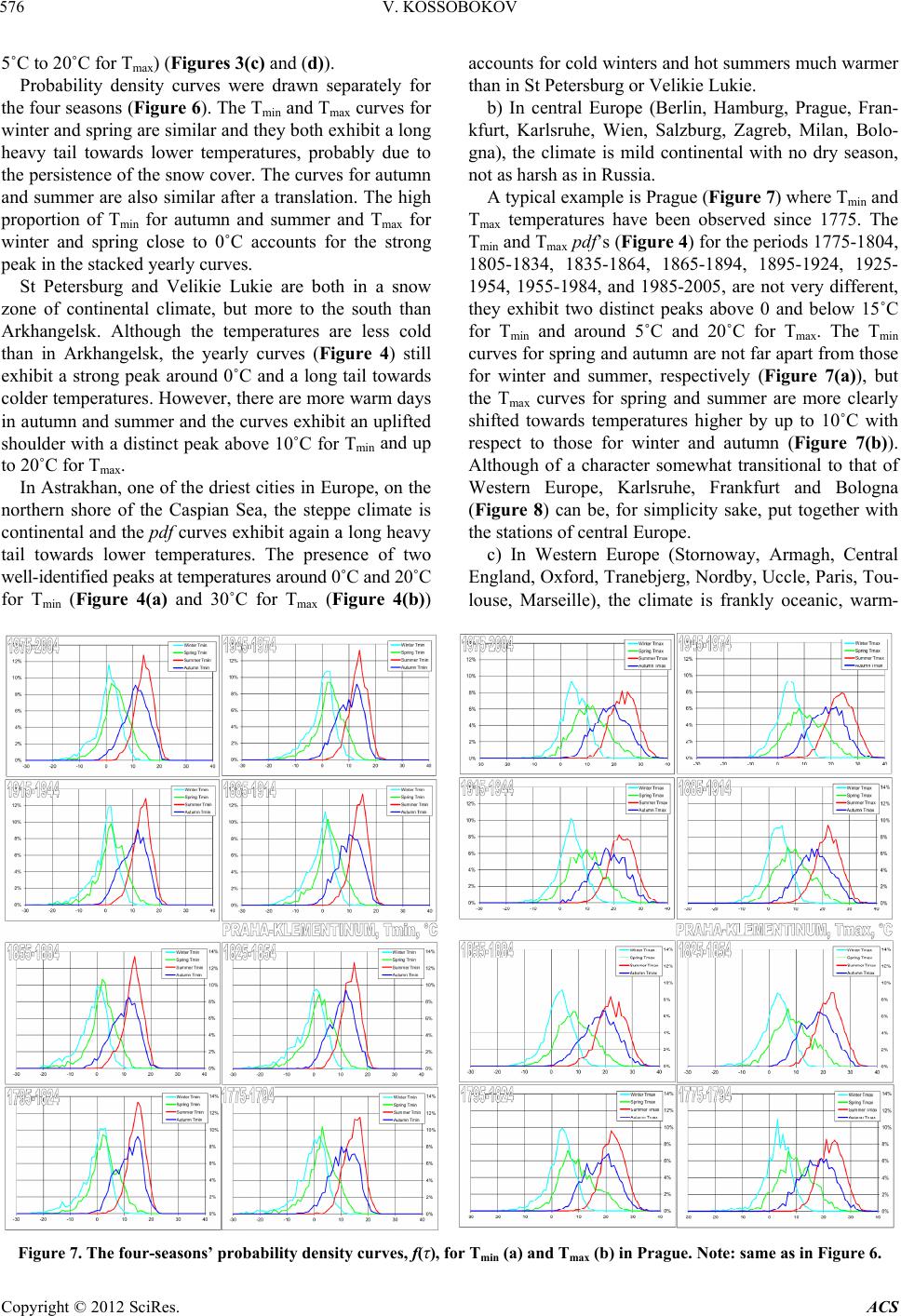 V. KOSSOBOKOV 576 5˚C to 20˚C for Tmax) (Figures 3(c) and (d)). Probability density curves were drawn separately for the four seasons (Figure 6). The Tmin and Tmax curves for winter and spring are similar and they both exhibit a long heavy tail towards lower temperatures, probably due to the persistence of the snow cover. The curves for autumn and summer are also similar after a translation. The high proportion of Tmin for autumn and summer and Tmax for winter and spring close to 0˚C accounts for the strong peak in the stacked yearly curves. St Petersburg and Velikie Lukie are both in a snow zone of continental climate, but more to the south than Arkhangelsk. Although the temperatures are less cold than in Arkhangelsk, the yearly curves (Figure 4) still exhibit a strong peak around 0˚C and a long tail towards colder temperatures. However, there are more warm days in autumn and summer and the curves exhibit an uplifted shoulder with a distinct peak above 10˚C for Tmin and up to 20˚C for Tmax. In Astrakhan, one of the driest cities in Europe, on the northern shore of the Caspian Sea, the steppe climate is continental and the pdf curves exhibit again a long heavy tail towards lower temperatures. The presence of two well-identified peaks at temperatures around 0˚C and 20˚C for Tmin (Figure 4(a) and 30˚C for Tmax (Figure 4(b)) accounts for cold winters and hot summers much warmer than in St Petersburg or Velikie Lukie. b) In central Europe (Berlin, Hamburg, Prague, Fran- kfurt, Karlsruhe, Wien, Salzburg, Zagreb, Milan, Bolo- gna), the climate is mild continental with no dry season, not as harsh as in Russia. A typical example is Prague (Figure 7) where Tmin and Tmax temperatures have been observed since 1775. The Tmin and Tmax pdf’s (Figure 4) for the periods 1775-1804, 1805-1834, 1835-1864, 1865-1894, 1895-1924, 1925- 1954, 1955-1984, and 1985-2005, are not very different, they exhibit two distinct peaks above 0 and below 15˚C for Tmin and around 5˚C and 20˚C for Tmax. The Tmin curves for spring and autumn are not far apart from those for winter and summer, respectively (Figure 7(a)), but the Tmax curves for spring and summer are more clearly shifted towards temperatures higher by up to 10˚C with respect to those for winter and autumn (Figure 7(b)). Although of a character somewhat transitional to that of Western Europe, Karlsruhe, Frankfurt and Bologna (Figure 8) can be, for simplicity sake, put together with the stations of central Europe. c) In Western Europe (Stornoway, Armagh, Central England, Oxford, Tranebjerg, Nordby, Uccle, Paris, Tou- louse, Marseille), the climate is frankly oceanic, warm- Figure 7. The four-seasons’ probability density curves, f(τ), for Tmin (a) and Tmax (b) in Prague. Note: same as in Figure 6. Copyright © 2012 SciRes. ACS 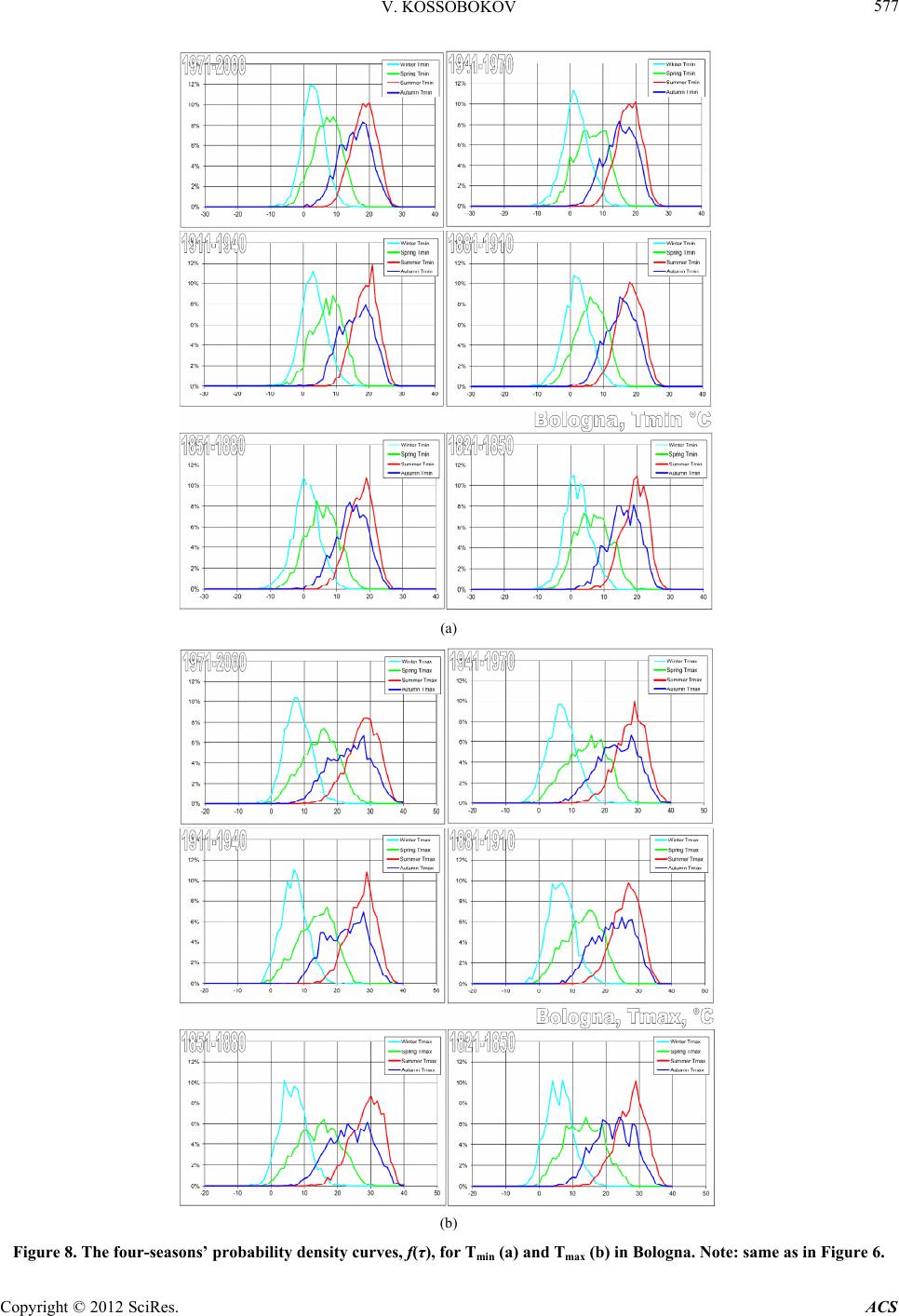 V. KOSSOBOKOV 577 (a) (b) Figure 8. The four-seasons’ probability density curves, f(τ), for Tmin (a) and Tmax (b) in Bologna. Note: same as in Figure 6. Copyright © 2012 SciRes. ACS 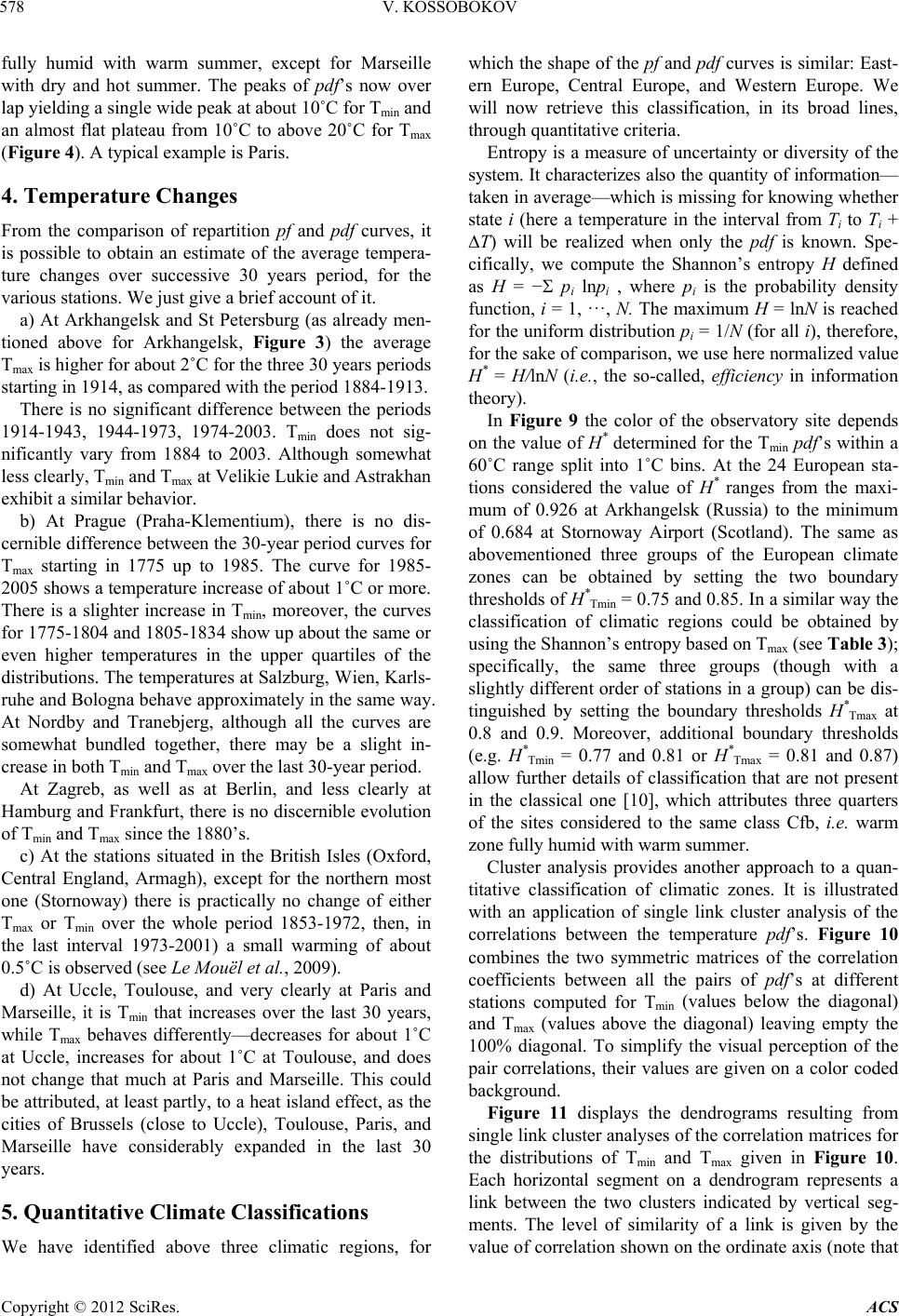 V. KOSSOBOKOV Copyright © 2012 SciRes. ACS 578 fully humid with warm summer, except for Marseille with dry and hot summer. The peaks of pdf’s now over lap yielding a single wide peak at about 10˚C for Tmin and an almost flat plateau from 10˚C to above 20˚C for Tmax (Figure 4). A typical example is Paris. 4. Temperature Changes From the comparison of repartition pf and pdf curves, it is possible to obtain an estimate of the average tempera- ture changes over successive 30 years period, for the various stations. We just give a brief account of it. a) At Arkhangelsk and St Petersburg (as already men- tioned above for Arkhangelsk, Figure 3) the average Tmax is higher for about 2˚C for the three 30 years periods starting in 1914, as compared with the period 1884-1913. There is no significant difference between the periods 1914-1943, 1944-1973, 1974-2003. Tmi n does not sig- nificantly vary from 1884 to 2003. Although somewhat less clearly, Tmin and Tmax at Velikie Lukie and Astrakhan exhibit a similar behavior. b) At Prague (Praha-Klementium), there is no dis- cernible difference between the 30-year period curves for Tmax starting in 1775 up to 1985. The curve for 1985- 2005 shows a temperature increase of about 1˚C or more. There is a slighter increase in Tmin, moreover, the curves for 1775-1804 and 1805-1834 show up about the same or even higher temperatures in the upper quartiles of the distributions. The temperatures at Salzburg, Wien, Karls- ruhe and Bologna behave approximately in the same way. At Nordby and Tranebjerg, although all the curves are somewhat bundled together, there may be a slight in- crease in both Tmin and Tmax over the last 30-year period. At Zagreb, as well as at Berlin, and less clearly at Hamburg and Frankfurt, there is no discernible evolution of Tmin and Tmax since the 1880’s. c) At the stations situated in the British Isles (Oxford, Central England, Armagh), except for the northern most one (Stornoway) there is practically no change of either Tmax or Tmin over the whole period 1853-1972, then, in the last interval 1973-2001) a small warming of about 0.5˚C is observed (see Le Mouël et al., 2009). d) At Uccle, Toulouse, and very clearly at Paris and Marseille, it is Tmin that increases over the last 30 years, while Tmax behaves differently—decreases for about 1˚C at Uccle, increases for about 1˚C at Toulouse, and does not change that much at Paris and Marseille. This could be attributed, at least partly, to a heat island effect, as the cities of Brussels (close to Uccle), Toulouse, Paris, and Marseille have considerably expanded in the last 30 years. 5. Quantitative Climate Classifications We have identified above three climatic regions, for which the shape of the pf and pdf curves is similar: East- ern Europe, Central Europe, and Western Europe. We will now retrieve this classification, in its broad lines, through quantitative criteria. Entropy is a measure of uncertainty or diversity of the system. It characterizes also the quantity of information— taken in average—which is missing for knowing whether state i (here a temperature in the interval from Ti to Ti + T) will be realized when only the pdf is known. Spe- cifically, we compute the Shannon’s entropy H defined as H = − pi lnpi , where pi is the probability density function, i = 1, ···, N. The maximum H = lnN is reached for the uniform distribution pi = 1/N (for all i), therefore, for the sake of comparison, we use here normalized value H* = H/lnN (i.e. , the so-called, efficiency in information theory). In Figure 9 the color of the observatory site depends on the value of H* determined for the Tmin pdf’s within a 60˚C range split into 1˚C bins. At the 24 European sta- tions considered the value of H* ranges from the maxi- mum of 0.926 at Arkhangelsk (Russia) to the minimum of 0.684 at Stornoway Airport (Scotland). The same as abovementioned three groups of the European climate zones can be obtained by setting the two boundary thresholds of H* Tmin = 0.75 and 0.85. In a similar way the classification of climatic regions could be obtained by using the Shannon’s entropy based on Tmax (see Table 3); specifically, the same three groups (though with a slightly different order of stations in a group) can be dis- tinguished by setting the boundary thresholds H* Tmax at 0.8 and 0.9. Moreover, additional boundary thresholds (e.g. H* Tmin = 0.77 and 0.81 or H* Tmax = 0.81 and 0.87) allow further details of classification that are not present in the classical one [10], which attributes three quarters of the sites considered to the same class Cfb, i.e. warm zone fully humid with warm summer. Cluster analysis provides another approach to a quan- titative classification of climatic zones. It is illustrated with an application of single link cluster analysis of the correlations between the temperature pdf’s. Figure 10 combines the two symmetric matrices of the correlation coefficients between all the pairs of pdf’s at different stations computed for Tmin (values below the diagonal) and Tmax (values above the diagonal) leaving empty the 100% diagonal. To simplify the visual perception of the pair correlations, their values are given on a color coded background. Figure 11 displays the dendrograms resulting from single link cluster analyses of the correlation matrices for the distributions of Tmi n and Tmax given in Figure 10. Each horizontal segment on a dendrogram represents a link between the two clusters indicated by vertical seg- ments. The level of similarity of a link is given by the value of correlation shown on the ordinate axis (note that 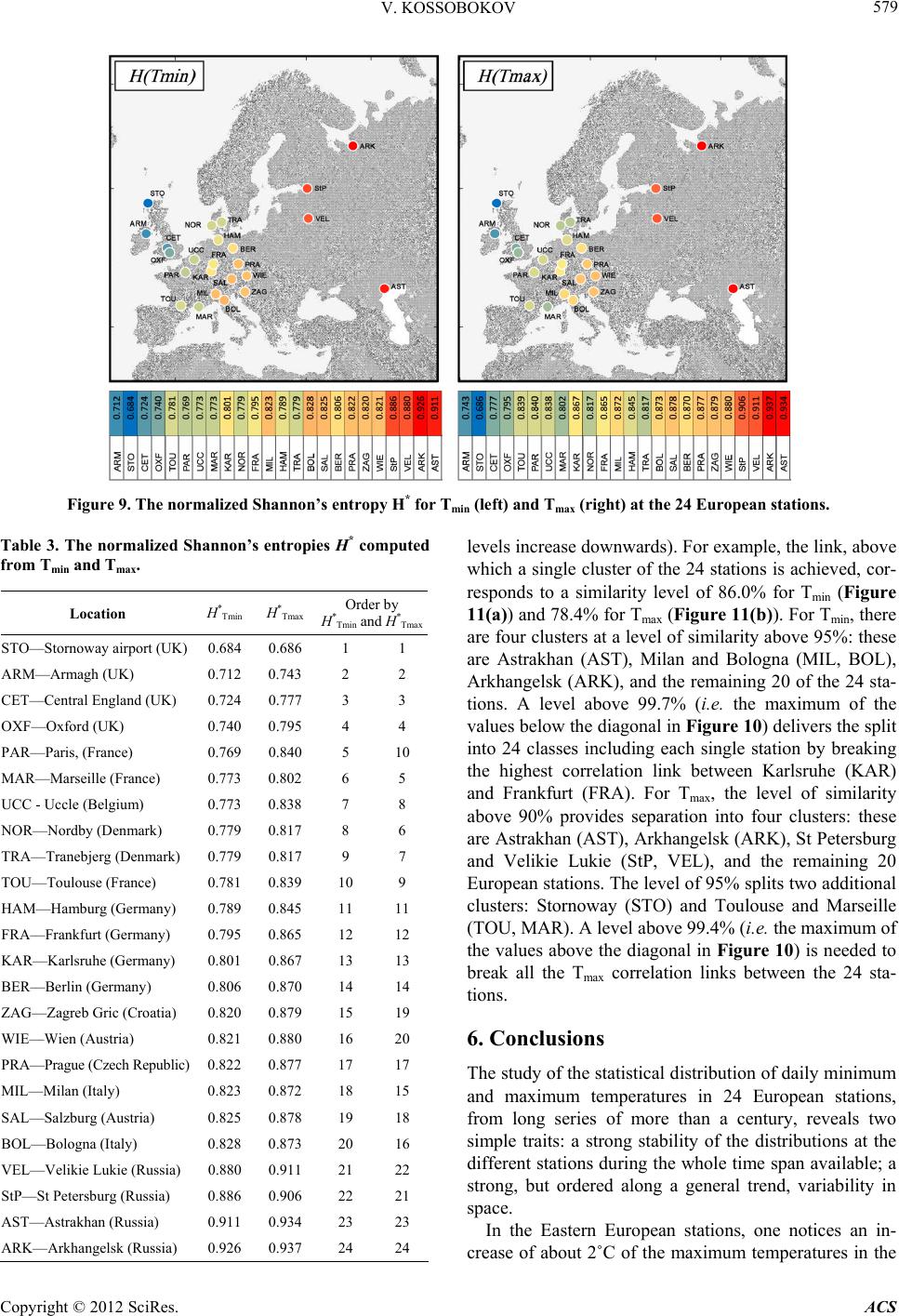 V. KOSSOBOKOV 579 Figure 9. The normalized Shannon’s entropy H* for Tmin (left) and Tmax (right) at the 24 European stations. Table 3. The normalized Shannon’s entropies H* computed from Tmin and Tmax. Location H*Tmin H*Tmax Order by H*Tmin and H*Tmax STO—Stornoway airport (UK) 0.684 0.686 1 1 ARM—Armagh (UK) 0.712 0.743 2 2 CET—Central England (UK) 0.724 0.777 3 3 OXF—Oxford (UK) 0.740 0.795 4 4 PAR—Paris, (France) 0.769 0.840 5 10 MAR—Marseille (France) 0.773 0.802 6 5 UCC - Uccle (Belgium) 0.773 0.838 7 8 NOR—Nordby (Denmark) 0.779 0.817 8 6 TRA—Tranebjerg (Denmark) 0.779 0.817 9 7 TOU—Toulouse (France) 0.781 0.839 10 9 HAM—Hamburg (Germany) 0.789 0.845 11 11 FRA—Frankfurt (Germany) 0.795 0.865 12 12 KAR—Karlsruhe (Germany) 0.801 0.867 13 13 BER—Berlin (Germany) 0.806 0.870 14 14 ZAG—Zagreb Gric (Croatia) 0.820 0.879 15 19 WIE—Wien (Austria) 0.821 0.880 16 20 PRA—Prague (Czech Republic) 0.822 0.877 17 17 MIL—Milan (Italy) 0.823 0.872 18 15 SAL—Salzburg (Austria) 0.825 0.878 19 18 BOL—Bologna (Italy) 0.828 0.873 20 16 VEL—Velikie Lukie (Russia) 0.880 0.911 21 22 StP—St Petersburg (Russia) 0.886 0.906 22 21 AST—Astrakhan (Russia) 0.911 0.934 23 23 ARK—Arkhangelsk (Russia) 0.926 0.937 24 24 levels increase downwards). For example, the link, above which a single cluster of the 24 stations is achieved, cor- responds to a similarity level of 86.0% for Tmi n (Figure 11(a)) and 78.4% for Tmax (Figure 11(b)). For Tmin, there are four clusters at a level of similarity above 95%: these are Astrakhan (AST), Milan and Bologna (MIL, BOL), Arkhangelsk (ARK), and the remaining 20 of the 24 sta- tions. A level above 99.7% (i.e. the maximum of the values below the diagonal in Figure 10) delivers the split into 24 classes including each single station by breaking the highest correlation link between Karlsruhe (KAR) and Frankfurt (FRA). For Tmax, the level of similarity above 90% provides separation into four clusters: these are Astrakhan (AST), Arkhangelsk (ARK), St Petersburg and Velikie Lukie (StP, VEL), and the remaining 20 European stations. The level of 95% splits two additional clusters: Stornoway (STO) and Toulouse and Marseille (TOU, MAR). A level above 99.4% (i.e. the maximum of the values above the diagonal in Figure 10) is needed to break all the Tmax correlation links between the 24 sta- tions. 6. Conclusions The study of the statistical distribution of daily minimum and maximum temperatures in 24 European stations, from long series of more than a century, reveals two simple traits: a strong stability of the distributions at the different stations during the whole time span available; a strong, but ordered along a general trend, variability in space. In the Eastern European stations, one notices an in- crease of about 2˚C of the maximum temperatures in the Copyright © 2012 SciRes. ACS 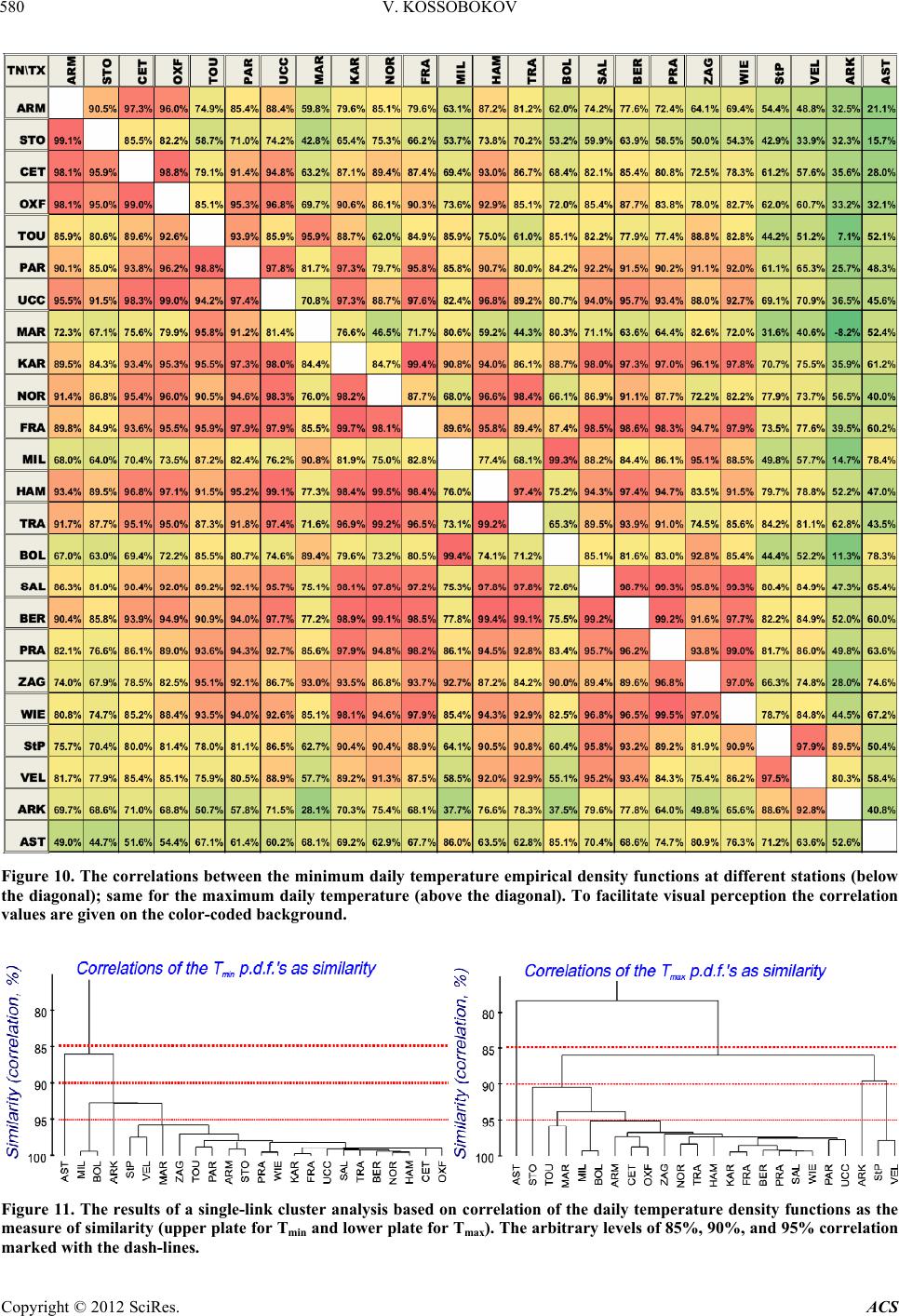 V. KOSSOBOKOV 580 Figure 10. The correlations between the minimum daily temperature empirical density functions at different stations (below the diagonal); same for the maximum daily temperature (above the diagonal). To facilitate visual perception the correlation values are given on the color- code d background. Figure 11. The results of a single-link cluster analysis based on correlation of the daily temperature density functions as the measure of similarity (upper plate for Tmin and lower plate for Tmax). The arbitrary levels of 85%, 90%, and 95% correlation marked with the dash-lines. Copyright © 2012 SciRes. ACS 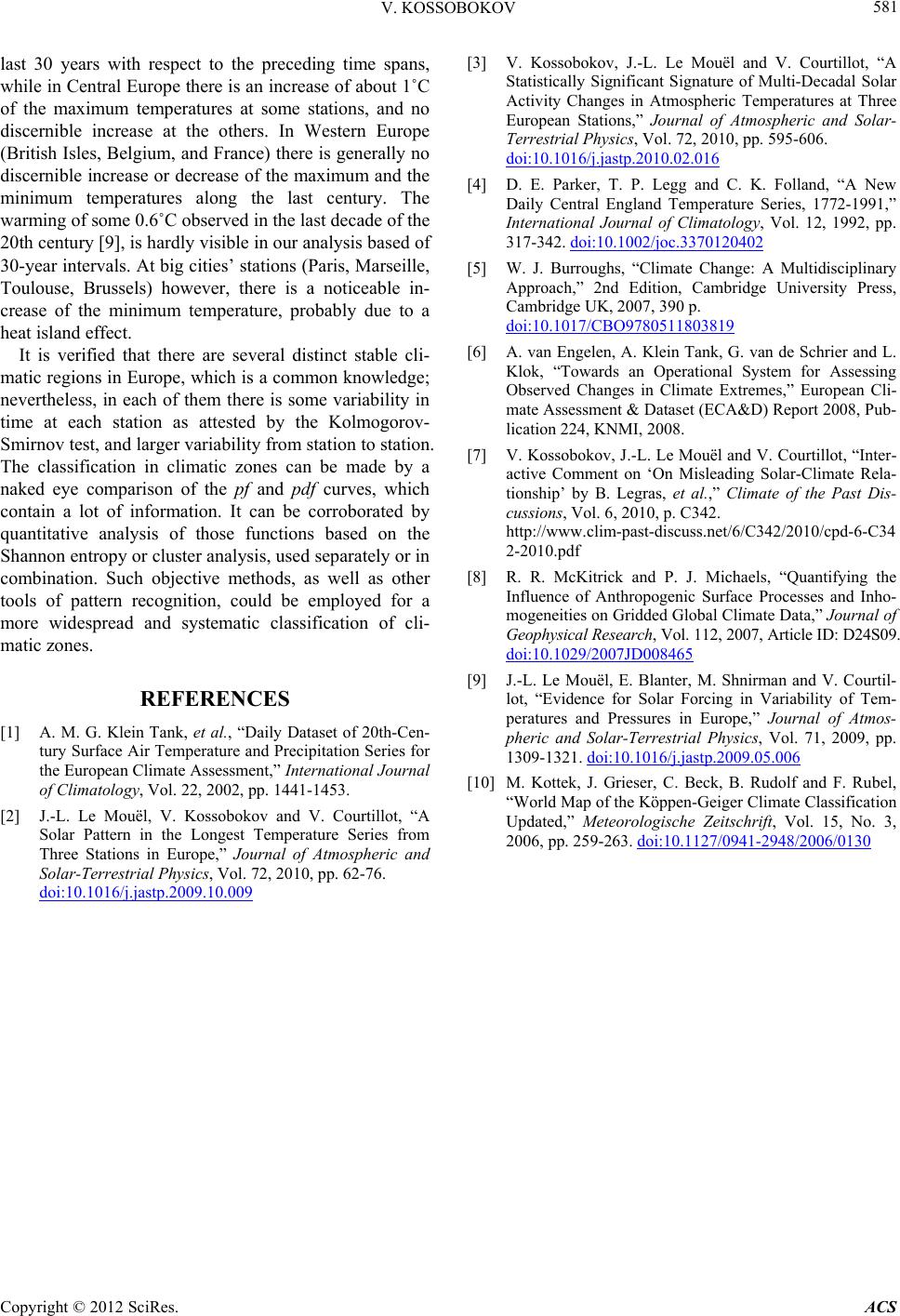 V. KOSSOBOKOV 581 last 30 years with respect to the preceding time spans, while in Central Europe there is an increase of about 1˚C of the maximum temperatures at some stations, and no discernible increase at the others. In Western Europe (British Isles, Belgium, and France) there is generally no discernible increase or decrease of the maximum and the minimum temperatures along the last century. The warming of some 0.6˚C observed in the last decade of the 20th century [9], is hardly visible in our analysis based of 30-year intervals. At big cities’ stations (Paris, Marseille, Toulouse, Brussels) however, there is a noticeable in- crease of the minimum temperature, probably due to a heat island effect. It is verified that there are several distinct stable cli- matic regions in Europe, which is a common knowledge; nevertheless, in each of them there is some variability in time at each station as attested by the Kolmogorov- Smirnov test, and larger variability from station to station. The classification in climatic zones can be made by a naked eye comparison of the pf and pdf curves, which contain a lot of information. It can be corroborated by quantitative analysis of those functions based on the Shannon entropy or cluster analysis, used separately or in combination. Such objective methods, as well as other tools of pattern recognition, could be employed for a more widespread and systematic classification of cli- matic zones. REFERENCES [1] A. M. G. Klein Tank, et al., “Daily Dataset of 20th-Cen- tury Surface Air Temperature and Precipitation Series for the European Climate Assessment,” International Journal of Climatology, Vol. 22, 2002, pp. 1441-1453. [2] J.-L. Le Mouël, V. Kossobokov and V. Courtillot, “A Solar Pattern in the Longest Temperature Series from Three Stations in Europe,” Journal of Atmospheric and Solar-Terrestrial Physics, Vol. 72, 2010, pp. 62-76. doi:10.1016/j.jastp.2009.10.009 [3] V. Kossobokov, J.-L. Le Mouël and V. Courtillot, “A Statistically Significant Signature of Multi-Decadal Solar Activity Changes in Atmospheric Temperatures at Three European Stations,” Journal of Atmospheric and Solar- Terrestrial Physics, Vol. 72, 2010, pp. 595-606. doi:10.1016/j.jastp.2010.02.016 [4] D. E. Parker, T. P. Legg and C. K. Folland, “A New Daily Central England Temperature Series, 1772-1991,” International Journal of Climatology, Vol. 12, 1992, pp. 317-342. doi:10.1002/joc.3370120402 [5] W. J. Burroughs, “Climate Change: A Multidisciplinary Approach,” 2nd Edition, Cambridge University Press, Cambridge UK, 2007, 390 p. doi:10.1017/CBO9780511803819 [6] A. van Engelen, A. Klein Tank, G. van de Schrier and L. Klok, “Towards an Operational System for Assessing Observed Changes in Climate Extremes,” European Cli- mate Assessment & Dataset (ECA&D) Report 2008, Pub- lication 224, KNMI, 2008. [7] V. Kossobokov, J.-L. Le Mouël and V. Courtillot, “Inter- active Comment on ‘On Misleading Solar-Climate Rela- tionship’ by B. Legras, et al.,” Climate of the Past Dis- cussions, Vol. 6, 2010, p. C342. http://www.clim-past-discuss.net/6/C342/2010/cpd-6-C34 2-2010.pdf [8] R. R. McKitrick and P. J. Michaels, “Quantifying the Influence of Anthropogenic Surface Processes and Inho- mogeneities on Gridded Global Climate Data,” Journal of Geophysical Research, Vol. 112, 2007, Article ID: D24S09. doi:10.1029/2007JD008465 [9] J.-L. Le Mouël, E. Blanter, M. Shnirman and V. Courtil- lot, “Evidence for Solar Forcing in Variability of Tem- peratures and Pressures in Europe,” Journal of Atmos- pheric and Solar-Terrestrial Physics, Vol. 71, 2009, pp. 1309-1321. doi:10.1016/j.jastp.2009.05.006 [10] M. Kottek, J. Grieser, C. Beck, B. Rudolf and F. Rubel, “World Map of the Köppen-Geiger Climate Classification Updated,” Meteorologische Zeitschrift, Vol. 15, No. 3, 2006, pp. 259-263. doi:10.1127/0941-2948/2006/0130 Copyright © 2012 SciRes. ACS
|